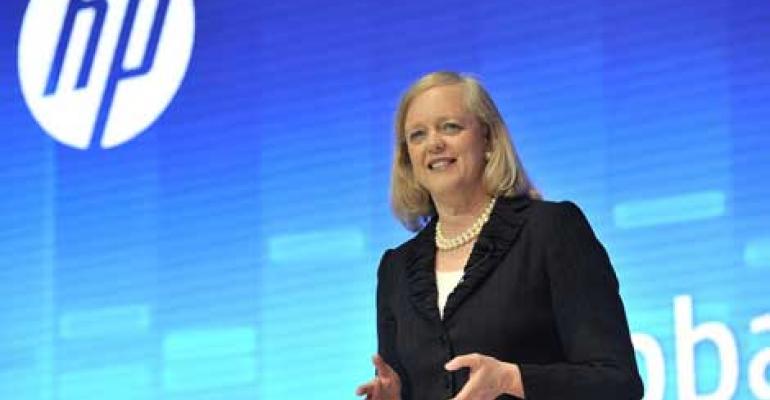HP reported another quarter of shrunk revenue Tuesday, but the company’s CEO Meg Whitman was upbeat on its Q4 fiscal 2014 earnings call about future prospects, relying on continued execution of her turnaround plan and separation of the giant into two separate companies – a move she announced three months ago.
It has been about three years since HP reported quarterly revenue growth, but the company’s margins have continued to improve as a result of implementation of Whitman’s ongoing multi-year turnaround plan, which includes letting go 55,000 employees.
Analysts have welcomed the changes – both the split and optimization of the overall business – but have pointed out that the big problem still remains: HP is shrinking.
Its PC business has shown growth, while the enterprise business, which includes hardware, software, and professional services, has not.
“Turnarounds aren’t linear,” Whitman said. “While we are seeing clear pockets of growth, other areas still need more work.”
HP’s revenue for the quarter was $28.4 billion, down 2 percent year over year. Profits were $1.3 billion, down 6 percent. Earnings per share were $0.70, down 4 percent.
Whitman attributed lack of growth this year to currency fluctuations. “We would grow this year in my view if we didn’t have the currency headwinds,” she said, adding that she expects next year’s revenue to be flat if currency value remains consistent.
Cloud is Hard to Win for Legacy Vendors
Both Whitman and HP CFO Cathie Lesjak said they expected the enterprise half to grow thanks to multiple new products introduced this year. These include ARM-based Moonshot servers, software defined networking products, and Helion, a portfolio of cloud services.
“It gives us some real upside,” Lesjak said about the enterprise group’s product lineup for the year.
Overall market dynamics may be working against HP in its current state, however, even as the company focuses on growing its cloud business. “Structurally, the cloud and virtualization model is not good for brand-name boxes, and that’s the bottom line,” Bloomberg Intelligence analyst Anand Srinivasan said in a Bloomberg-produced video.
Growth in the cloud market is happening primarily for businesses like Amazon Web Services, Microsoft Azure, and Google, which don’t buy brand-name hardware from the likes of HP. They buy generic low-cost boxes directly from Taiwanese manufacturers, he said.
‘Execution Machine’ for Separation
Whitman is expecting the split into HP Enterprise (which she will lead) and HP Inc. to help a lot. Each company will benefit from better cost structure, focus on its respective market segment, and better alignment with customer needs and market changes, she said.
HP has created a big team focused on implementing separation full time. Whitman said the group would be between 400 and 500 people strong at its peak, referring to it as an “execution machine.”
“It is the biggest separation that’s ever been done,” she said. “These are two Fortune 50 companies. It’s big, and it’s complex, but we’ve got the best people on it.”
The management is looking at separation as an opportunity to further optimize operations of each company. The process will include rethinking everything from operations and IT infrastructure to go-to-market strategy and supply chain for each entity.





